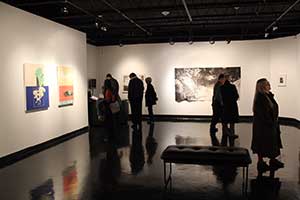Gallery History
Memory and Momentum
The Gallery was dedicated in 1978 in honor of Edward Mitchell Bannister, a noted 19th century African American artist who was also influential in the society and culture of the Providence community of his time. Bannister is a significant figure in the history of American Landscape painting and in the annals of social progress in this country for African Americans and other historically marginalized peoples. This link to Bannister's biography tells this story.
Exhibitions of fine art at RIC actually pre-date this 25 year period somewhat. Prior to 1978, exhibitions were presented at the Adams Library for at least 5 years. The year 1977-78 marks the construction of first real 'Gallery' as a purpose - built facility, with high quality track lighting, plywood lined walls, and its striking black tile floor.
With a view to the spirit of the late 1970's, the inception of the gallery as the first such full-time exhibition space at RIC came at a turning point in American culture and education in general. Following upon decades of traumatic civil, racial, and military strife - the assassination of the Kennedy's and the Rev. Martin Luther King Jr., the widespread race riots, the angst and tumult of the Vietnam War, the rise of the Counter Culture - the establishment of the gallery signified not only a new commitment to the value of visual arts at the College but also, in its dedication to Bannister, parallels a time where the wider culture acknowledged a more complex and inclusive vision of history, culture and values.
This social change was also reflected within the art world and broader visual culture; as contemporary artists in general enjoyed greater freedoms and credibility.The spirit of the times was not specific to redressing the rights and recognition of African-Americans alone, but to the rights and freedom of expression of all people, and echoed the egalitarian spirit of Bannister's Providence of a century before, which similarly - followed the tumult and divisiveness of a (the) Civil War.

Perhaps because of this background out of which the gallery 'solidified', and within the broad spectrum of exhibitions presented over the past 25 years, there may be found one recurring theme. This is, that visual art is a powerful and effective language with which to address issues beyond the purely aesthetic or formal and in ways which either epitomize or help us focus on important socio-political and philosophical problems. Not to dismiss the issues and history of aesthetics or pure formal studies specifically of interest to artists, as these are also well embedded in the exhibition program and thematically predominate on the schedule.
The Bannister Gallery operates as an exhibition space for works of contemporary art. It is not a museum and does not own or specialize in E.M. Bannister's artwork as is sometimes assumed. Primarily, the gallery's function is as a teaching resource of the Department of Art, with exhibits selected by a rotating body of faculty to highlight aspects of their courses and various disciplines. This results, in a very democratic and vibrant forum for a diverse range of media and subjects.
Guided by a committee of visual art faculty and the director, the gallery program strives for a consistent quality of presentation and a respect for a broad range of viewpoints and sensibilities. This is a program that is shaped and run by visual artists who are also educators and as such is more open-ended, democratic, and challenging than commercial venues and many museums. I think that we've managed over the years to keep an 'edge' to what we present that reminds viewers that Art is still a developing language of communication, and a mode of understanding; rather than a known quantity or a form of entertainment.
The gallery was located in the RIC Art Center from 1978 to 2000. It was relocated in August 2000 to Roberts Hall, which afforded a greater proximity to the Performing Arts and Music facilities. It was formally re-dedicated to the memory of E.M. Bannister in October 2000 in conjunction with the completion of the Nazarian Center for the Performing Arts. Recently the exhibit space was expanded to the adjacent hallway with the installation of 140 square feet of glass display cases and other improvements provided through the auspices of the RIC Foundation.
The gallery presents monthly exhibitions during the academic year, and one exhibit during summer sessions. Along with exhibits, the gallery regularly hosts presentations by artists, curators, performance artists and other guest lecturers of note. Gallery programming is presented through the cooperation of the Department of Art Gallery Committee, the RIC Art Club, the Artist Co-Op, the Performing and Fine Arts Commission, the Committee for Lectures and Films, the Dean of the Faculty of Arts and Sciences, the E.M. Bannister Society and the RIC Foundation.
Over the years the Bannister Gallery has presented the work of artists such as Dale Chihuly, Coreen Simpson, Jerome Witkin, Gordon Parks, Mahler Ryder, Arno Minkinnen, Bruce Chao, Robert Birmelin,Willy Heeks, David Macaulay, Peggy Cyphers, Guliermo Gomez-Pena and Roberto Sifuentes, Misch Kohn, Clarissa Sligh, Gabor Peterdi, Jim Goldberg, Michael Kvium, Bill Seaman, Terry Allen, and Andrew Forge - to name just a few.
All of the exhibits, lectures, and events have been made available, free of charge, to the college and public.

